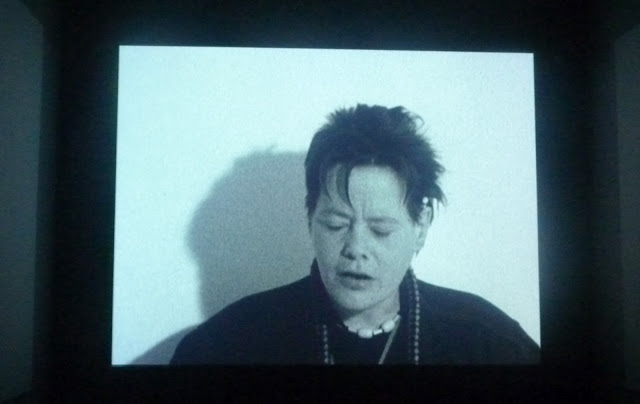Gillian Wearing, at Whitechapel Gallery.
Gillian Wearing's main interest lies in the way individuals present themselves to others. She is interested in the space between the private and public, in the difference between fiction and reality and the relationship betweeen the artist and viewer.
She has been influenced by the work of sociologist Erving Goffman, The Presentation of Self in Everyday Life, in which he details the ways that we have 'frontstage and backstage personalities', that we perform all the time, and that when we are behind closed doors we go into a bit 'of a slump'. She has been a devotee of reality television since pioneering 60s documentaries (56up is on our T.V. screens at the moment) as well as Celebrity Big Brother and the rest.
She was among the first to anticipate and dramatise the implications of the loss of the sanctity of public space, of the idea that what you might want to say to your best friend is not appropriate or desirable for strangers to hear. The boundaries between public and private space have been irretrievably blurred. "Facebook and Twitter are there for similar reasons", she says, "because people want to have their voices heard beyond friends and family".
Seeing the exhibition last Thursday was very apt as I am reading 'Look at Me' by Jennifer Egan at the moment, where the themes of identity, how individuals present themselves to others and the difference between what we see and what lies beneath, are explored. The need to be famous, to have one's life exposed for all to see is another theme of the novel and has clear similarities to the work of Wearing.
A series of darkened rooms are installed in Gallery 1, where videos and films with staging techniques borrowed form TV and film, are shown.
Here Wearing asked a participant to direct a scene that was relevant to him.
A woman that Wearing wanted to interview but who died in the interim - the film is accompanied by the voice of her twin sister.
Some of the scenes in those films were almost too painful to watch, particularly the one of a mother and daughter where abuse was being re-enacted.
"I'm always trying to find ways to discover things about people and in the process discover more things about myself".
Self-Portrait
Self-Portraits as....
In recent years, inspired by old photos of her family she has set out to recreate them through impersonation, wigs, costumes and sculptural masks. Here she seems to be questioning our very identity - are we nothing more than our past, our parents and our dreams?
Contact sheet from shoot of Self Portrait as my sister Jane Wearing
She achieved this recreation of her family by meticulously creating silicone sculpted masks and prosthetics of her subjects' features, allowing her to inhabit the likeness of her family members in a performative and physical way - looking at the masks we create for ourselves we can reveal the secrets of our true identity.
Sculpture of the artist's sister's face as Self-Portrait as my Sister Jane Wearing
Self-Portrait as my Sister Jane Wearing, 2003
Self-Portrait as my Brother Richard Wearing, 2003
Self-Portrait, aged 17, 2003
Self-Portrait of Me Now with Mask
A group of complementary images show her spiritual family: artists who, like herself, were interested in notions of identity and staging, such as Diane Arbus, Andy Warhol, Robert Mapplethorpe.
Me as Diane Arbus
Me as Warhol in Drag with Scar, 2010
Signs that say what you want to them to say, and not signs that say what someone else wants you to say.
This is to date her most famous work and one that has been extensively copied: she approached people at random on London streets and asked them to write down on a piece of card what was on their minds. The images are very revealing, giving viewers an instant snapshot of worlds of interiors.
"When I did them it was a million miles away from where we are now. In 1992, we were still being given this line that British people are reserved and don't like to express what they are feeling".
2 into 1 (1997)
In this video a mother and her twin sons describe each other's character traits - she put the boys' words into the mother's mouth and vice versa, exposing the often confusing simultaneity of love and cruelty that characterise family relations, that people are aware of, but hardly ever talk about in public.


















No comments:
Post a Comment